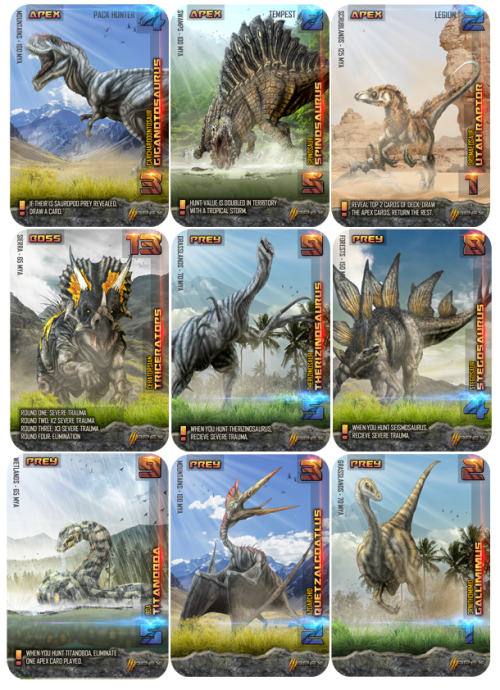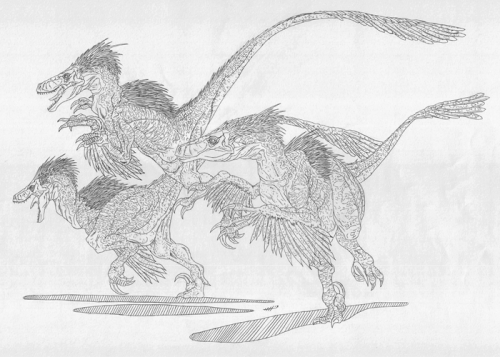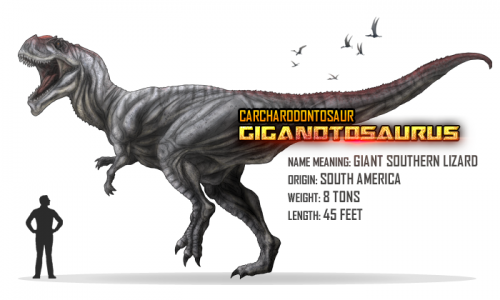Random
Herschel Hoffmeyer, Dinosaur Enthusiast
 “I’ve been learning about and drawing dinosaurs since I was a kid,” explains Herschel Hoffmeyer, creator of the Apex Theropod Deck-Building Game, now on Kickstarter. “I even won a dinosaur art contest at a local library when I was very little. I was made to create these guys and bring them to life.”
“I’ve been learning about and drawing dinosaurs since I was a kid,” explains Herschel Hoffmeyer, creator of the Apex Theropod Deck-Building Game, now on Kickstarter. “I even won a dinosaur art contest at a local library when I was very little. I was made to create these guys and bring them to life.”
Apex Theropod looks like a dinosaur-lover’s nocturnal emission…and Herschel himself might be the biggest dino-enthusiast you’ll ever meet. “I have National Geographic’s The Ultimate Dinopedia and the super-sized book Dinosaurs by David James. I really love what the indie company Lukewarm Media has done with their game Primal Carnage,” he gushes, adding as an afterthought that he hasn’t actually been able to play said game yet.
According to his Kickstarter bio, Herschel is an 8-year Army veteran and Game Art and Design student at the Arts Institute International in Kansas City. Intrigued about how his Army life segued into his current saurian pursuits, I contacted Herschel for an interview. “Apex started as a simple prototype dinosaur-themed game used for an assignment in one of my game design classes at the Arts Institute International of Kansas City,” he explained. “After seeing my game concepts compared to others, I knew I had a knack for game design. Shortly after, I worked on many different prototype games under the same dinosaur theme, game goals, and playable class ideas.”
“The dinosaur theme was definitely the theme from the beginning, just because I thought it would be really fun to play.” As for the mechanics, they were inspired by the Legendary: A Marvel Deck-Building Game, published by Upper Deck Entertainment. Like other deck-building games, Legendary starts each player with a small deck of relatively weak cards (in this case, S.H.I.E.L.D. agents). However, over the course of the game, they can use these cards to “recruit” more powerful, iconic Marvel heroes into their deck, and the winner will be the player who builds the cleverest deck in the shortest time. This evolution from humble beginnings is a potently addictive formula, which explains the explosion of popularity deck-builders have experienced since they were popularized by Donald X. Vaccarino’s Dominion in 2008. Herschel isn’t naive to the economics of the situation: one reason he selected the deck-building format is that, since the bulk of their contents are composed of duplicate cards, deck-builders are relatively inexpensive to manufacture.
 This evolutionary gameplay is also the perfect complement to the theme of becoming the world’s top saurian predator. Herschel explains, “Most of the game’s mechanics are shaped around the theme, and three are really unique to the game. The first is the territory-based decks. With the environmental deck affecting those territories, that drives a sense of environment immersion. The second is that each player has a nest. The nest is separate from your playing deck and unique to whatever dinosaur you’re playing as. In the nest, you hatch cards that consist of just your dinosaur, and you also bring any prey hunted back to your nest to eat later. The third unique mechanic is the unforgiving boss battles. To dominate each territory, you have to fight off the other competing apex predator of that territory, and that is the boss. In a 5-player game, you have eight total bosses, and in a single-player game, you have three bosses and one ultimate boss.”
This evolutionary gameplay is also the perfect complement to the theme of becoming the world’s top saurian predator. Herschel explains, “Most of the game’s mechanics are shaped around the theme, and three are really unique to the game. The first is the territory-based decks. With the environmental deck affecting those territories, that drives a sense of environment immersion. The second is that each player has a nest. The nest is separate from your playing deck and unique to whatever dinosaur you’re playing as. In the nest, you hatch cards that consist of just your dinosaur, and you also bring any prey hunted back to your nest to eat later. The third unique mechanic is the unforgiving boss battles. To dominate each territory, you have to fight off the other competing apex predator of that territory, and that is the boss. In a 5-player game, you have eight total bosses, and in a single-player game, you have three bosses and one ultimate boss.”
Yes, Apex can be enjoyed by a single player. “The main difference with a one-player game is that you are fighting the clock, the environment effect deck, and at the bottom of it is a one-player-specific Apex Boss. You still have the bosses associated with the territories, but you only have three territories to choose from in a one-player game. If the Apex Boss shows up before you dominate two out of those three territories, you are automatically eliminated. The Apex Boss battle is a more in-depth boss battle system, and you win if you defeat him. Each playable dinosaur will also be an Apex Boss.”
 Like anybody else whose interest in prehistoric animals survived the mass personality extinction event called adolescence, Herschel has a few bones to pick with their popular media portrayal. “Well, the most obvious ones are in movies. The ones that bother me the most are when Disney doubled the size and mass of Carnotaurus in their movie Dinosaur and the fight with T. rex against Spinosaurus in Universal’s Jurassic Park 3.”
Like anybody else whose interest in prehistoric animals survived the mass personality extinction event called adolescence, Herschel has a few bones to pick with their popular media portrayal. “Well, the most obvious ones are in movies. The ones that bother me the most are when Disney doubled the size and mass of Carnotaurus in their movie Dinosaur and the fight with T. rex against Spinosaurus in Universal’s Jurassic Park 3.”
“There’s a couple of things wrong with that battle in JP3,” he elucidates. “The first is that T. rex gains the upper hand early in the fight against Spino by clamping down on the spine lizard’s neck. T. rex’s jaws were designed to crush bones, especially ones in the neck that can easily be broken. The fight would have been over instantly. However, Spinosaurus was a behemoth, and was actually even bigger than he appeared in JP3. His spine was also much greater in size, and he was missing his nasal crest. Due to their relative mass, I’m afraid T. rex would never have had the option to bite onto Spino’s neck.”
Herschel’s pet peeves go beyond mere factual inaccuracies. “Dinosaurs simply don’t get the respect they earned,” he complains. “The most famous of all, Tyrannosaurus rex, was a very deadly monster with the strongest bite force in the history of land animals. However, there’s a whole lineup of dinosaurs that could have sent rex to its grave if they’d lived side-by-side. My goal is to always give each dinosaur the reputation it earned and nothing more.”
 More than just a game, Apex attempts to be as factually accurate as possible in its visual and mechanical depiction of the dinosaurs. Each dino card even lists the historical habitat and time period in which the animal lived. “When designing Apex, I mostly wanted to target the more mature audience, but I knew kids were going to play it as well. I thought the game could be an awesome learning experience for adults, as well, because dinosaurs have changed so much since we were kids. For the prototype, I included one distinct fact about the dinosaur on every card, but the cards began to look messy, so I removed them. That’s how I came up with the Dinosaur Guide, so the people can still learn about the dinosaurs and I could showcase all the artwork used in one place.”
More than just a game, Apex attempts to be as factually accurate as possible in its visual and mechanical depiction of the dinosaurs. Each dino card even lists the historical habitat and time period in which the animal lived. “When designing Apex, I mostly wanted to target the more mature audience, but I knew kids were going to play it as well. I thought the game could be an awesome learning experience for adults, as well, because dinosaurs have changed so much since we were kids. For the prototype, I included one distinct fact about the dinosaur on every card, but the cards began to look messy, so I removed them. That’s how I came up with the Dinosaur Guide, so the people can still learn about the dinosaurs and I could showcase all the artwork used in one place.”
The Dinosaur Guide, a 20-page booklet of illustrations and facts, is available on the Kickstarter for $18 or bundled together with other pledge tiers. “The Dinosaur Guide is pretty much like a small dinosaur encyclopedia that consists of only the dinosaurs used in Apex,” Herschel explains. “When choosing what dinosaurs I wanted to include, I focused on two things: fan favorites when we were kids and newly discovered dinosaurs that stood out from the rest. The Dinosaur Guide will include newly discovered information about those old favorites, as well as all the info we know about the newcomers.”

What if we want to imagine our own apex predator showdown? “All dinosaurs in the guide will be to relative scale, as well, so any page you flip to, you can accurately compare sizes of two different dinosaurs from two different pages (and eras).”
When asked about why he thinks people should support the project, Herschel replied, “The main reason is because I thought it would be cool to play out the most recent talked-about dinosaur battle between a T. rex and Spinosaurus. You can do that in Apex!”
What about an Apex Quadruped game? “I don’t know if there will be much demand for a Quadruped game, so probably not.” Disappointing, I know, but maybe we can still change his mind; there are over 3 weeks remaining to voice your opinion on the Kickstarter’s comments section.
***
Byron Alexander Campbell is an aspiring human living in Southern California. He is interested in games, story, and the surprising ways they intersect.
Tags: Apex Theropod, Byron Alexander Campbell, dinosaurs, Herschel Hoffmeyer, kickstarter
